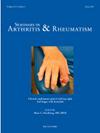比较雷诺现象攻击测量工具:纸张还是智能手机应用?
IF 4.4
2区 医学
Q1 RHEUMATOLOGY
引用次数: 0
摘要
目的比较两种记录雷诺现象(RP)发作频率、持续时间和严重程度的方法:传统的雷诺状态评分(RCS)纸质日记和新型智能手机应用程序。方法对稳定型SSc-RP患者进行多中心研究。参与者被随机分配在RCS纸质日记或智能手机应用程序中记录他们的RP攻击一周,然后他们再次被随机分配继续原来的记录方法或切换到另一种记录方法多一周。跨界的参与者完成了一份关于他们使用每种方法的经验的问卷调查。我们比较了患者的偏好,并记录了RP文件。结果纳入55例稳定型SSc-RP患者。使用两种方式的24名参与者更有可能报告“喜欢”智能手机应用程序而不是纸质日记(92%对58%,p=0.04)。与纸质日记相比,智能手机的实时记录也没有显著差异(71%对38%,p=0.06)。参与者报告说,使用纸质日记的攻击次数明显多于使用智能手机应用程序的攻击次数,然而,严重程度和平均攻击时间没有显著差异。结论:本研究支持使用智能手机应用程序记录RP攻击频率、持续时间和严重程度。患者不仅更喜欢智能手机应用程序而不是纸质日记,而且他们更有可能用智能手机应用程序实时记录RP发作,从而降低了回忆偏差的风险。未来的临床试验应该考虑使用基于智能手机的应用程序来捕捉RP攻击。本文章由计算机程序翻译,如有差异,请以英文原文为准。
Comparing Raynaud’s phenomenon attack measurement tools: paper or smartphone application?
Objective
To compare two methods of recording Raynaud’s Phenomenon (RP) attack frequency, duration and severity: the traditional Raynaud Condition Score (RCS) paper diary and a new smartphone application.
Methods
We conducted a multicenter study of patients with stable SSc-RP. Participants were randomized to document their RP attacks in the RCS paper diary or smartphone application for one week, at which point they were again randomized to either continue the original recording method or cross over to the other recording method for an additional week. Participants who crossed over completed a questionnaire about their experience with each method. We compared patient preference, and RP documentation by recording method.
Results
Fifty-five patients with stable SSc-RP were included. The 24 participants who used both modalities were significantly more likely to report “liking” the smartphone application than the paper diary (92% vs. 58%, p=0.04). There was also a non-significant difference in real-time documentation with the smartphone than the paper diary (71% vs. 38%, p=0.06). Participants reported significantly more attacks with the paper diary than with the smartphone application, however, the severity and average attack length were not significantly different.
Conclusion
This study supports the use of a smartphone application to document RP attack frequency, duration and severity. Not only did patients prefer the smartphone application to the paper diary, but they were also more likely to record RP attacks in real-time with the smartphone application, reducing the risk of recall bias. Future clinical trials should consider using a smartphone-based application to capture RP attacks.
求助全文
通过发布文献求助,成功后即可免费获取论文全文。
去求助
来源期刊
CiteScore
9.20
自引率
4.00%
发文量
176
审稿时长
46 days
期刊介绍:
Seminars in Arthritis and Rheumatism provides access to the highest-quality clinical, therapeutic and translational research about arthritis, rheumatology and musculoskeletal disorders that affect the joints and connective tissue. Each bimonthly issue includes articles giving you the latest diagnostic criteria, consensus statements, systematic reviews and meta-analyses as well as clinical and translational research studies. Read this journal for the latest groundbreaking research and to gain insights from scientists and clinicians on the management and treatment of musculoskeletal and autoimmune rheumatologic diseases. The journal is of interest to rheumatologists, orthopedic surgeons, internal medicine physicians, immunologists and specialists in bone and mineral metabolism.

 求助内容:
求助内容: 应助结果提醒方式:
应助结果提醒方式:


